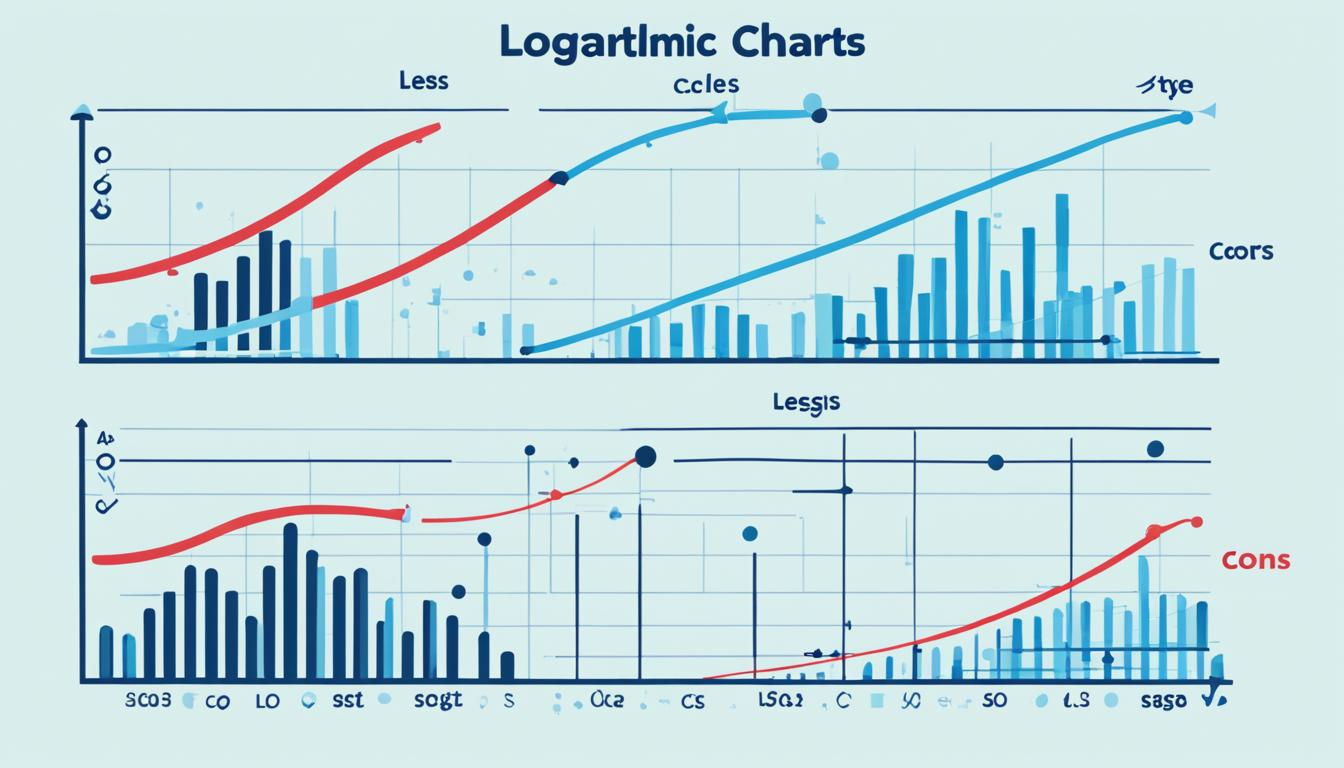As a trader or technical analyst, you may often find yourself faced with the decision of which chart type to use when analyzing price movements. Two common options are logarithmic and linear charts. Each has its own set of benefits and advantages, and understanding the differences between them can help you make more informed decisions in your analysis. Let’s delve into the world of logarithmic and linear charting and explore their pros and cons.
Logarithmic charts utilize a logarithmic scale, which represents price spacing on the vertical axis based on the percentage of change in the underlying asset’s price. This scale allows for a visualization of less severe price increases or decreases and emphasizes the magnitude of price changes. On the other hand, linear charts use an equidistant spacing between designated prices, providing simplicity in chart design and a clear representation of how far the price must move to reach a target level.
When should you use logarithmic charts? These charts are particularly useful when analyzing assets with significant price movements or when you want to focus on the percentage change in price rather than the absolute value. On the other hand, linear charts are well-suited for shorter-term analysis and less volatile assets, where the absolute value of price changes may be more relevant.
It’s worth noting that logarithmic charts can become congested and difficult to interpret when prices are close together, while linear charts may underrepresent price changes for low-priced securities and overrepresent changes for high-priced securities. By understanding the strengths and limitations of each chart type, you can make more accurate and informed analyses.
Now that we’ve explored the basics of logarithmic and linear charts, let’s dive deeper into their key differences, chart design considerations, and the advantages they offer in various analysis scenarios.
Key Takeaways:
- Logarithmic charts use a logarithmic scale to show the percentage change in price, emphasizing the magnitude of price changes.
- Linear charts use an equidistant spacing between designated prices, providing simplicity in chart design.
- Logarithmic charts are beneficial for assets with significant price movements, while linear charts are well-suited for shorter-term analysis and less volatile assets.
- Logarithmic charts may become congested when prices are close together, while linear charts may underrepresent or overrepresent price changes depending on the asset’s price level.
- Understanding the strengths and limitations of logarithmic and linear charts helps you choose the appropriate chart type for accurate analysis.
Logarithmic Price Scale
A logarithmic price scale is a powerful tool used by technical analysts and traders to analyze price movements. Unlike a linear price scale, which represents price spacing on the vertical axis with equal distances between designated prices, a logarithmic price scale takes into consideration the percentage of change in price.
On a logarithmic scale, prices are not positioned equidistantly. Instead, the scale represents commonly recurring percent changes with equal spacing between the numbers. This means that a 100% increase or decrease in price will be represented by the same distance on the scale, regardless of the absolute price values. It allows for a more accurate visualization of the percentage change and the magnitude of price movements.
Logarithmic price scales are particularly useful for visualizing less severe price increases or decreases. They allow traders and technical analysts to better understand the relative changes in price, especially when dealing with assets that have experienced significant price growth or high levels of volatility.
However, it’s important to note that logarithmic scales can become congested and difficult to interpret when prices are close together. In such cases, it may be necessary to switch to a different scale or chart type to ensure clarity in analyzing the price movements.
Linear Price Scale
A linear price scale, also known as an arithmetic chart, is a widely used method of representing price on the vertical axis. In this chart type, equal distance is maintained between listed prices, creating a scale that allows for easy interpretation of price movements.
On a linear price scale, each unit change is represented by the same vertical distance on the scale, irrespective of the asset’s price level. This equal distance allows for a straightforward visualization of how the price must move to reach a target level, making it particularly useful for shorter-term analysis and less volatile assets.
The simplicity and ease of drawing linear charts manually contribute to their popularity among traders and analysts. They provide a clear and concise representation of price changes, enabling quick and intuitive analysis.
However, it’s important to note that linear charts may not always accurately represent price changes when the security price is low relative to other prices on the chart. In such cases, the scale may underrepresent price movements, making it harder to identify and analyze minor fluctuations.
Conversely, when the security price is relatively high, linear charts may overrepresent price changes, potentially magnifying the significance of certain price movements. Therefore, it’s crucial to consider the context and overall scale of the chart when interpreting the data.
In conclusion, the linear price scale, with its equal distance between prices, offers simplicity and ease of analysis. It excels in illustrating the distance the price needs to move to reach a target level. However, it is important to be mindful of its limitations when analyzing low-priced or high-priced securities. By considering the unique characteristics of the asset being analyzed, the linear price scale can be an effective tool in understanding price dynamics.
Comparison of Logarithmic and Linear Price Scales
| Aspect | Logarithmic Price Scale | Linear Price Scale |
|---|---|---|
| Representation of Price Movements | Emphasizes percent changes | Shows equal dollar price increases |
| Vertical Distance | Varies based on percentage change | Remains constant for each unit change |
| Usefulness | Ideal for long-term analysis and less severe price changes | Suitable for shorter-term analysis and target level visualization |
| Complexity | Can become congested and harder to interpret when prices are close together | Simpler and easier to draw manually |
Note: The above table showcases the key differences between logarithmic and linear price scales, providing insights into their unique characteristics and areas of applicability.
Key Differences
When comparing logarithmic and linear price scales, it becomes clear that their key differences lie in how they represent price increases. Understanding these distinctions can help determine the appropriate chart type for specific analysis needs.
Logarithmic Scale:
A logarithmic chart uses a logarithmic scale to represent price increases. On this scale, equal percent changes are depicted by an equal vertical distance, irrespective of the absolute price values. This unique feature allows for a visual representation of the magnitude of price changes. Logarithmic charts are particularly useful for analyzing price movements with different magnitudes.
Linear Scale:
In contrast, a linear chart utilizes a linear scale to represent price increases. On this scale, equal dollar price increases are shown with an equal vertical distance. While both logarithmic and linear scales depict the same absolute difference in price, linear scales emphasize dollar changes rather than percent changes. Linear charts are typically favored for shorter-term analysis and less volatile assets.
Here is a comparison between logarithmic and linear scales:
| Logarithmic Scale | Linear Scale |
|---|---|
| Emphasizes percent changes | Emphasizes dollar changes |
| Visual representation of magnitude | Representation of absolute values |
| Effective for analyzing various magnitudes | Suitable for shorter-term analysis |
Choosing the Right Chart Type
When deciding between logarithmic and linear charts, it is essential to consider the characteristics of the data and the specific analysis needs. Logarithmic charts are advantageous for visualizing and analyzing price movements with different magnitudes, as they highlight percent changes. On the other hand, linear charts are simpler and more suitable for shorter-term analysis and less volatile assets, focusing on dollar changes.
By understanding the key differences between logarithmic and linear scales, you can make an informed decision on which chart type best serves your analysis needs.
Conclusion
In conclusion, when it comes to chart scaling and data presentation, it is important to consider the pros and cons of both logarithmic and linear charts. The choice between these two chart types ultimately depends on your specific analysis needs and the type of data being presented.
Logarithmic charts are particularly beneficial for visualizing less severe price increases or decreases and for understanding the magnitude of price changes. They are often favored for long-term analysis, as they can provide valuable insights into overall trends and patterns.
On the other hand, linear charts offer simplicity and are more suitable for shorter-term analysis and less volatile assets. They can help visualize the distance the price needs to move to reach a target level, making them useful for setting price targets and identifying potential entry or exit points.
By understanding the strengths and weaknesses of logarithmic and linear charts, you can make informed decisions about which chart scaling method best suits your analysis needs and allows for the most accurate data presentation.


